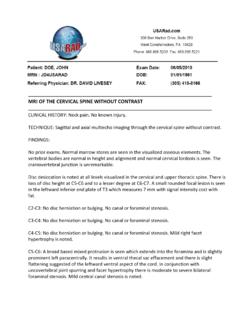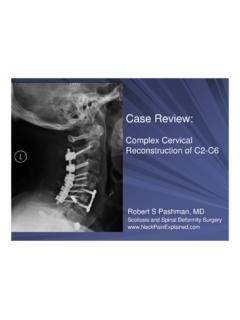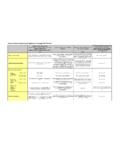Transcription of Guidelines for Treatment of the Cervical Spine- …
1 OKLAHOMA. Guidelines FOR Treatment OF. THE Cervical spine . Developed and Adopted by the Physician Advisory Committee Adopted by the Administrator of the Oklahoma Workers' Compensation Court Effective August 15, 2009. TABLE OF CONTENTS. INTRODUCTION .. 1. BACKGROUND .. 1. DEVELOPMENT OF THE Guidelines .. 1. APPLICATION OF THE 1. I. THERAPEUTIC PROCEDURES NON-OPERATIVE .. 1. A. BACKGROUND .. 1. B. GENERAL PRINCIPLES .. 2. C. INITIAL DIAGNOSTIC EVALUATION .. 3. D. ADVANCED DIAGNOSTIC IMAGING AND TESTING PROCEDURES .. 3. E. THERAPEUTIC 4. F. NOT 4. G. MEDICATIONS .. 4. H. OCCUPATIONAL REHABILITATION PROGRAMS .. 4. I. ORTHOTICS .. 5. J. PERSONALITY/PSYCHOLOGICAL/PSYCHOSOCIAL INTERVENTION .. 5. K. THERAPY-PASSIVE (MODALITIES) .. 5. L. THERAPY ACTIVE .. 5. II. THERAPEUTIC PROCEDURES OPERATIVE.
2 6. A. BACKGROUND .. 6. B. ACUTE FRACTURES AND DISLOCATIONS.. 6. C. DISC HERNIATION AND OTHER Cervical CONDITIONS .. 7. D. ARTIFICIAL Cervical DISC REPLACEMENT .. 10. E. PERCUTANEOUS RADIOFREQUENCY DISC DECOMPRESSION .. 10. F. EPIDUROSCOPY AND EPIDURAL LYSIS OF 10. G. INTRAOPERATIVE MONITORING .. 10. Guidelines FOR Treatment OF. THE Cervical spine . developed and adopted by the PHYSICIAN ADVISORY COMMITTEE. Adopted by the Administrator of the Oklahoma Workers' Compensation Court Effective August 15, 2009. INTRODUCTION. BACKGROUND: The Physician Advisory Committee (PAC), a statutorily created advisory body to the Oklahoma Workers' Compensation Court, has been directed by Oklahoma Statute to develop and recommend Treatment Guidelines for injured Oklahoma workers. The PAC is composed of nine members; three appointed by the Governor, three appointed by the President Pro Tempore of the State Senate, and three appointed by the Speaker of the Oklahoma House of Representatives.
3 By statute, the Governor's appointees must include a doctor of medicine and surgery, a family practitioner in a rural community of the state, and an osteopathic physician; the President Pro Tempore's appointees must include a doctor of medicine and surgery, a doctor of medicine or an osteopathic physician, and a podiatric physician; and the Speaker's appointees must include an osteopathic physician, a doctor of medicine or an osteopathic physician, and a chiropractic physician. DEVELOPMENT OF THE Guidelines : The Committee received input from a wide variety of sources including employers, insurance carriers, and health care providers. Appropriate scientific literature has been reviewed. The Occupational Medicine Practice Guidelines promulgated by the American College of Occupational and Environmental Medicine and the Official Disability Guidelines published by the Work Loss Data institute, and practice parameters of the American Academy of Orthopaedic Surgeons were reviewed.
4 Treatment protocols from Colorado, Washington, Minnesota, California, Rhode Island, and West Virginia were also utilized. APPLICATION OF THE Guidelines : These Treatment Guidelines should not be construed as including all proper methods of care or excluding other acceptable methods of care which are based upon nationally accepted practice standards. For injury or illness treated under the Oklahoma Workers= Compensation Act, compliance with these Treatment Guidelines is mandatory and an employer or insurer for an employer is not required to pay for Treatment which is not in compliance with the Treatment Guidelines , unless prior authorization is received. If prior authorization is refused, independent review may be obtained under court procedures. Authorization for Treatment may not be denied on the sole basis the Treatment is not addressed by these Guidelines if it is documented to be based upon nationally accepted practice standards.
5 These Guidelines do not affect any determination of liability for an injury under the Oklahoma Workers'. Compensation Act, 85 , Section 1, et seq., and are not intended to expand or restrict a health care provider's scope of practice under any other statutes. I. THERAPEUTIC PROCEDURES NON-OPERATIVE. A. BACKGROUND. 1. This Treatment guideline for the diagnosis and conservative Treatment of neck pain is a consensus document based on nationally accepted practice standards and is not a scientific treatise on the subject. 2. It is understood that a certain number of injured employees treated under this guideline will require continued care that may transition to other Treatment Guidelines . 1. 3. This Treatment guideline is meant to cover the majority of tests and treatments for injured workers with Cervical pain.
6 However, it is expected that up to 10% of cases may fall outside these Treatment Guidelines and require review on a case-by-case basis. 4. Although the primary purpose of this document is advisory and educational, these Guidelines are enforceable under Title 85, Section (B) (5). The Physician Advisory Committee recognizes that acceptable medical practice may include deviations from these Treatment Guidelines as individual cases dictate. Therefore, these Guidelines are not relevant as evidence of a provider's legal standard of care. 5. It is anticipated that these Guidelines will only be applicable for no more than six months following the injury. 6. The natural history of neck pain is such that within three months of the injury, 90% of all injured workers should no longer require active medical Treatment .
7 B. GENERAL PRINCIPLES. 1. Treatment Parameter Duration. Time frames for specific interventions begin once specific Treatment has been initiated and not on the date of injury. 2. Active interventions. Active interventions (therapeutic exercise and/or functional Treatment ) are emphasized over passive modalities, especially as Treatment progresses. Generally, passive interventions are viewed as a means to facilitate the transition to an active rehabilitation program. 3. Positive Patient Response. These results are defined primarily as functional gains that can be objectively measured, such as positional tolerances, range of motion, strength, endurance, activities of daily living (ADL), cognition, psychological behavior, and efficiency/velocity measurements. Subjective reports of pain and function should be considered and given relative weight when the pain has an anatomic and/or physiological basis.
8 All findings must be based on objective medical evidence. 4. Re-evaluate Response to Treatment at least every 3-4 weeks. If a given Treatment is not producing the desired effect within three to four weeks, the Treatment should either be modified or discontinued. If a rational intervention fails to produce the desired effect, the diagnosis of the condition under Treatment should be re-considered. 5. Surgical Interventions. Surgical Interventions for neck pain are covered in a companion Treatment guideline. 6. Six-month time frame. As many studies have documented, the prognosis of an injured employee returning to work drops precipitously after the employee has been temporarily totally disabled for more than six months. The emphasis within these Guidelines is to move patients along a continuum of care and return to work before the six-month mark, whenever possible.
9 It is important to note that these time frames may not be pertinent for injuries that do not involve work- time loss or are not occupationally-related. 7. Return-to-work. Work is therapeutic, assuming that the work is not likely to aggravate the basic problem or increase long-term pain. Even if there is residual chronic pain, return to work is not necessarily contraindicated. 8. Delayed Recovery. The Physician Advisory Committee recognizes that 3-10% of all industrially injured patients will not recover within 6-12 weeks of the index injury. Such individuals may require Treatment beyond the limits discussed within this document, but such Treatment will require clear documentation by the treating physician focusing on objective functional gains afforded by further Treatment and its impact on prognosis.
10 9. Guideline Recommendations and Inclusion of Medical Evidence. All recommendations in this Treatment guideline are considered to represent reasonable care in appropriately selected cases, regardless of the level of evidence attached to it. Those procedures considered inappropriate, unreasonable, or unnecessary are designated in the Treatment guideline as not recommended . 2. 10. Care Beyond MMI. Maximum medical improvement (MMI) should be declared by the treating physician when the patient's condition has plateaued to the point that further medical intervention is unlikely to result in improved functional outcome. However, some patients may require Treatment after MMI has been reached in order to maintain their functional state. The recommendations in this Treatment guideline are for pre-MMI care and are not intended to limit post-MMI Treatment .








